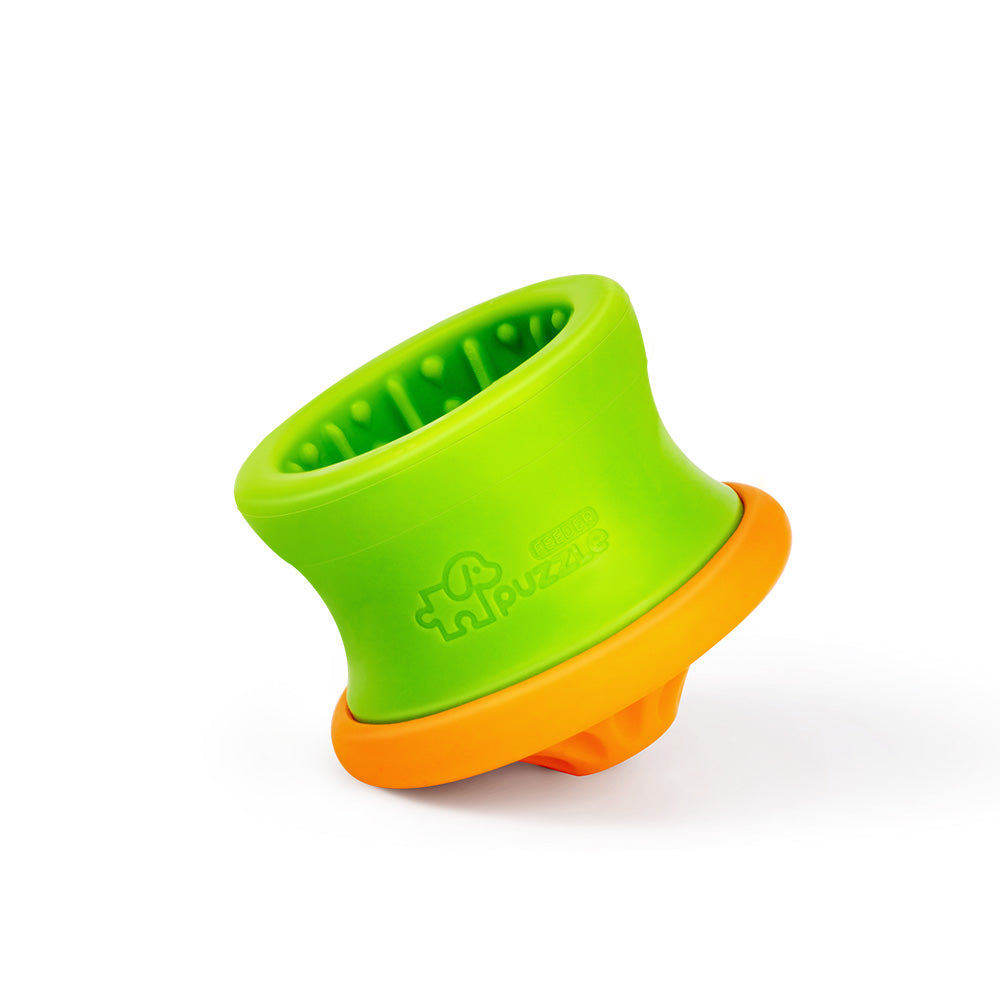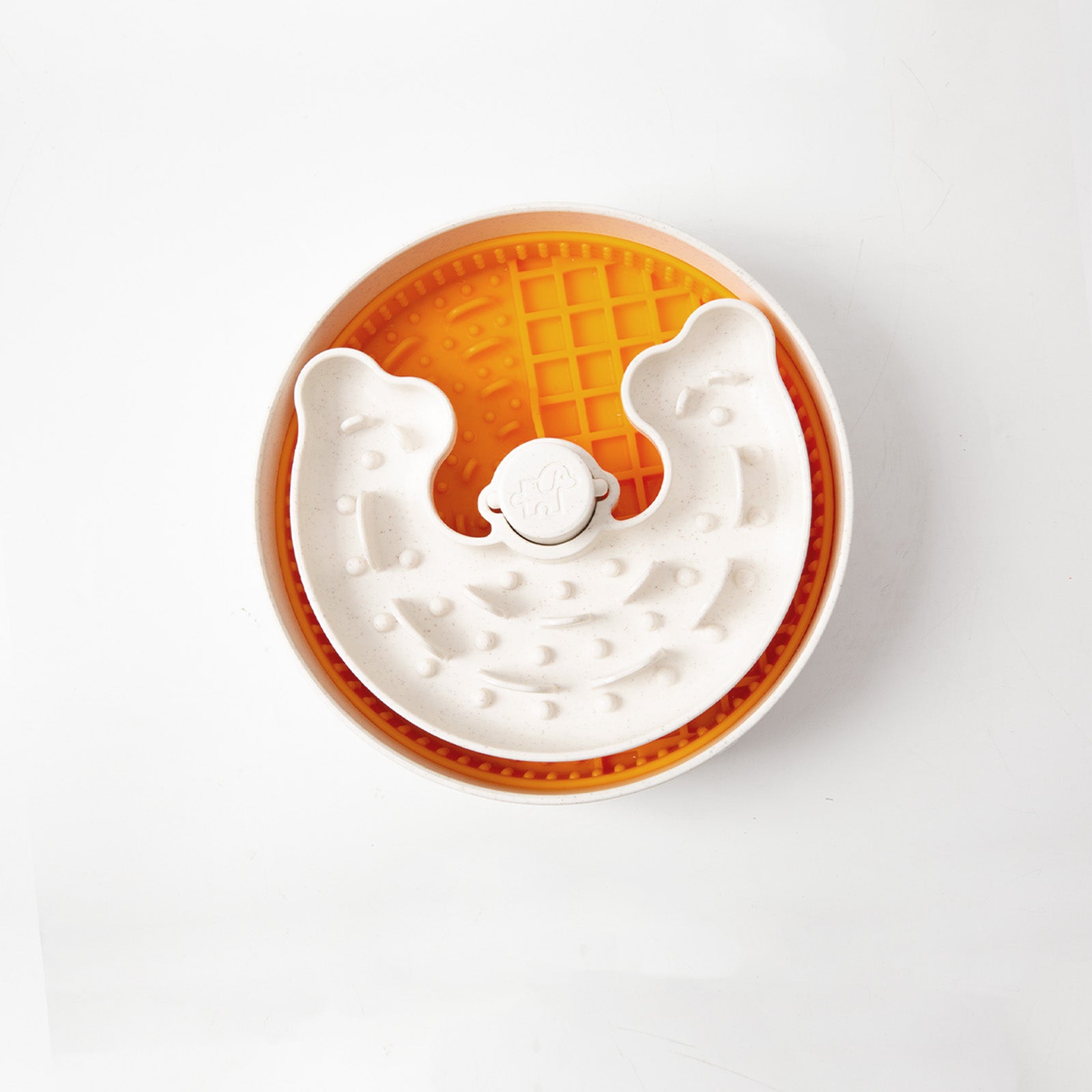In the rush of daily life, it’s easy to overlook how quickly our dogs eat. However, the pace of their eating can have a significant impact on their health and well-being.
Let’s explore why dogs eat too fast, the benefits of slow feeding, and why a Puzzle Feeder™ is the perfect tool to transform mealtime for your furry friend.
Why Do Dogs Eat Too Fast?
Understanding why dogs eat too fast is the first step in addressing the issue:
Instinctual Drive: Dogs inherit survival instincts from their wild ancestors, leading them to eat quickly to secure food.
Competitive Eating: In multi-pet households or shelters, dogs may develop a habit of racing to finish meals due to competition.
Boredom and Anxiety: A lack of mental stimulation or stress in their environment can cause dogs to eat rapidly as a coping mechanism.

Risks of Fast Eating
While a dog eating too fast might seem harmless, it can lead to serious health problems and behavioral challenges:
Choking Hazard: Rapid eating increases the risk of choking as large food pieces may become lodged in the throat.
Digestive Problems: Gulping food impedes digestion, causing bloating, gas, and stomach discomfort. Severe cases may lead to gastric dilatation-volvulus (GDV), a life-threatening condition.
Obesity: Fast eaters are more likely to overeat since their brains don’t register fullness quickly enough. Over time, this can lead to obesity and related health issues.
Benefits of Dog Slow Feeding
Introducing slow feeding into your dog’s routine can bring numerous advantages:
Improved Digestion: Slower eating allows better chewing, aiding digestion and reducing stomach issues.
Reduced Choking Risk: Puzzle feeders and other slow-feeding tools prevent gulping, lowering the risk of choking.
Weight Management: Mindful eating helps dogs recognize when they’re full, promoting healthy weight control.
Mental Stimulation: Slow feeders engage your dog’s mind, providing enrichment and reducing boredom or anxiety.
Choosing the Right Puzzle Feeder

Selecting the right Puzzle Feeder™ is crucial for fostering healthier eating habits. Here’s what to look for:
Texture Variety: Opt for feeders with obstacles like ridges, mazes, or raised patterns. These designs slow eating and encourage mindful consumption.
Customizable Accessories: Puzzle Feeder™s are customizable with accessories such as sniffing mats, "Broken Wave" mats, or licking mats. Switching up these elements keeps mealtime engaging, prevents boredom, and can be used to gradually train your dog to eat slower.
Material Safety: Choose feeders made from food-grade, non-toxic materials such as BPA-free plastic, stainless steel, or ceramic. Avoid any with harmful chemicals.
Ease of Cleaning: Look for feeders that are easy to disassemble and clean. Dishwasher-safe options or removable inserts make maintenance simple and ensure hygiene.
Alternative Options: Consider tools like Puzzle Tumblers, which provide variety and mental stimulation, without discomfort.
Transform Mealtime with a Puzzle Feeder™
Incorporating a Puzzle Feeder™ into your dog’s routine can lead to long-term health and happiness:
Better Digestion and Satiety: Slower eating aids nutrient absorption and helps your dog feel full, reducing overeating.
Prevention of Serious Health Risks: Slow feeding minimizes the dangers of choking, bloat, and digestive issues.
Enrichment and Calmness: Engaging feeders provide mental stimulation, helping to alleviate boredom and ease dog anxiety.
Customizable Mealtime: By using a variety of accessories like sniffing mats or licking mats, you can keep meals interesting and reduce stress.
Easy Maintenance: Puzzle feeders are made from safe, durable materials and are often dishwasher-safe, making them both convenient and hygienic.

Why Puzzle Feeder™?
Prioritizing your dog’s health and happiness starts with addressing their eating habits. By using a Puzzle Feeder™, you’re not only preventing the risks of eating too fast but also enriching their daily life. Transform mealtime into a healthier, more enjoyable experience for your furry companion!

















Оставить комментарий
Все комментарии перед публикацией проверяются.
Этот веб-сайт защищается hCaptcha. Применяются Политика конфиденциальности и Условия использования hCaptcha.